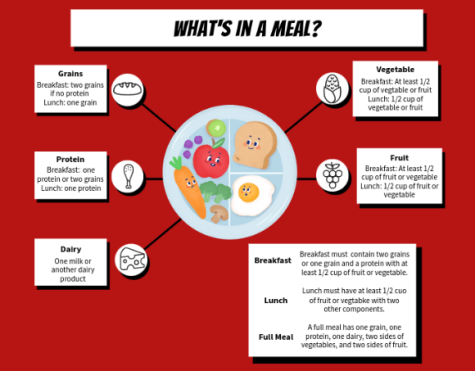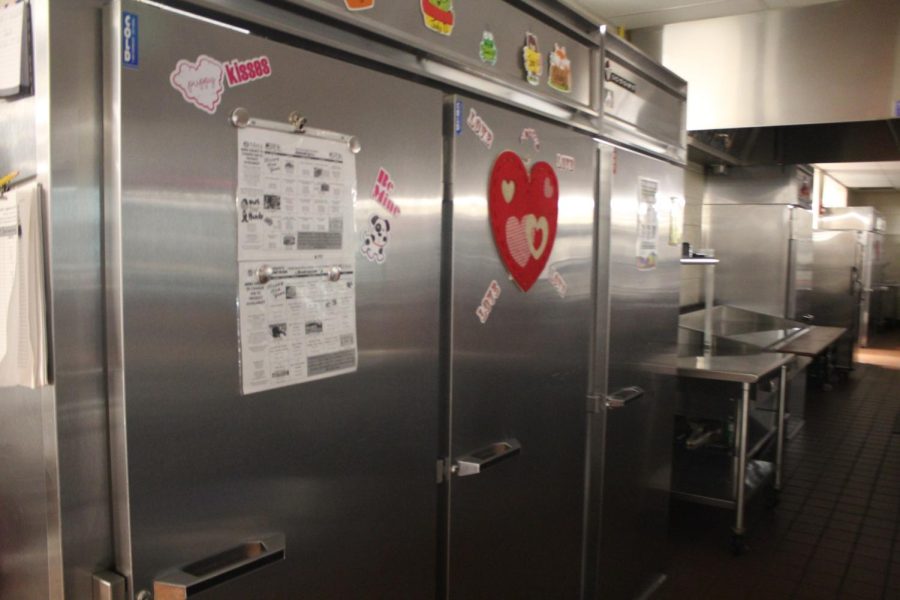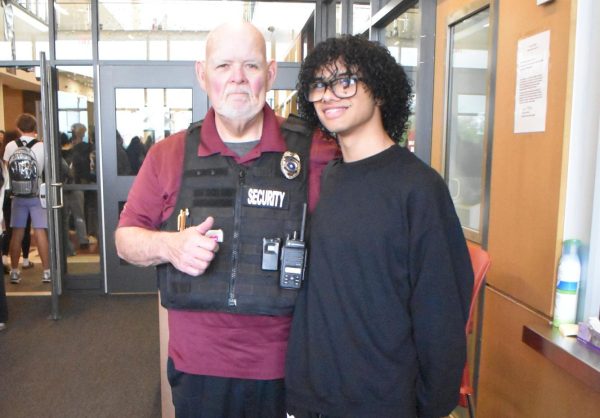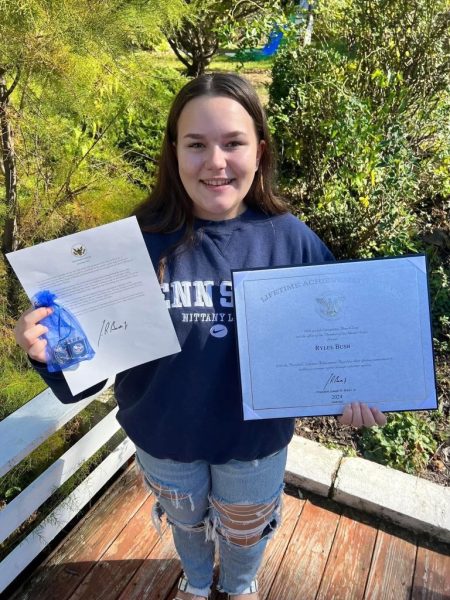Not all a piece of cake: Reimer discusses reasoning behind lunch
Snacking A tray full of junior high food sits on top of a table. The junior high has monitors in the cafeteria to make sure students are not eating food and other add-ons while in the cafeteria.
I hear the same question almost every day.
“What’s for lunch today, Dom?”
Mackenzie Negri, American Studies teacher, is always intrigued by the answer. Instead of looking on the school website, she asks sophomore Dominick Zlupko, an announcer on MLTV, who often reads out the lunch menu for the day. He’ll say the offered meal which then turns into a discussion about the school food. One topic that never fails to come up is the difference between the junior high and high school’s lunches.
It’s a topic heard discussed throughout the past two years. Sometimes, it’s about the junior high’s sweet sugary snacks that didn’t transfer over to the high school cafeteria. Other times, it’s about the differences in seating space.
The general manager of the AASD cafeteria department, Heather Reimer, explained why these differences occur. Although all of the 12 buildings receive the same food, there are many different factors that go into the school lunches: time, space, staff, vendors, age and the food requirements.
One of the biggest challenges for Reimer is the space availability at the high school. While the junior high has two large seating areas and a spacious cafeteria, the high school has a different version. There are two sections for seating and two cafeteria areas which are smaller compared to the junior high. This makes it harder for Reimer and the cafeteria staff to serve students in the same way the junior high staff does. It can also make some students have a harder time getting food because of how crowded the area ends up being.
“I think it’s the environment that makes them feel the openness, inviting, not rushed, not congested feeling,” Reimer said.” I do think that plays a role in how you feel about your food.”
The lesser amount of space at the high school has caused some options to become unavailable. This includes snacks like ice cream, cookies and Rice Krispies Treats. There is no space in the cafeteria for these options to be set up at, so Reimer is unable to sell them.
Because of the spacing issue and the addition of a freshman class, Reimer had asked for additional spacing in the new building when plans were first being made. However, this request was never fulfilled. Reimer has no idea as to why this happened, but she doesn’t blame anyone for this occurrence.
“There are other plans that have to be taken into consideration. While it is disappointing, I do understand,” Reimer said.
The time frame for lunches differs between the high school and junior high as well. Students at the high school get 25 minutes to get to the cafeteria and eat their food. There are four different lunches with no time in between. The junior high students have 34 minutes, meaning there is an additional nine minutes for them to get and eat their food. There is also 10-12 minutes between each lunch. The extra time between lunches allows for the staff to prepare for the next wave of students by getting food ready.

The additional time for the junior high students also allows them to order more customizable food. The junior high has a ‘made to order’ approach with the deli station that mirrors the idea of Subway. Students are allowed to pick out what toppings they want on their foods while high school students just pick up a wrapped hoagie or buffalo chicken flatbread.
Less time to eat has discarded some of the previous ideas for lunches the staff had. Reimer and the high school manager, Tracey Stiffler, came up with an idea to make a lunch that mirrored the idea of a Chipotle bowl. Many of the ingredients were already in storage along with hot plates to keep the food warm; however, the time frame made it hard for this idea to become a reality. Too many kids would have to choose what they wanted to eat, and it would take up time from students’ lunch periods.
Instead of having the Chipotle bowl, there are days where tacos and nachos are available. The lettuce, cheese, tomato and other toppings are already separated into bags for students to take while going through the line. It makes the process much faster, so students don’t have to wait as long to eat.
The set up of the cafeterias also impacts how fast and easy it is for the staff to prepare food and get it to students. The junior high kitchen is all in the same area, with the kitchen being directly connected to the cafeteria. The high school does have a kitchen in between the two cafeteria areas, but it is much smaller. Some of the storage is also below the kitchen, which takes up more time for preparation.

The nutrition needs for age groups can determine what a meal looks like for the different schools. Although the percent value of saturated fats stays the same for all groups at 10 percent, the calorie and sodium requirements differ. The minimum to maximum calorie intake for grades six to eight is 600-700 throughout a five day week. The intake increases to 750-850 for grades nine to 12. This can change the types of foods and the amount of food being offered.
While these conditions can be difficult for the staff to work around, they do try to come up with solutions to make sure the students are satisfied. When vendors are unable to bring certain food items, the managers work together and come up with other options that they believe will be enticing to the students.
“We’ve always had [food]. There’ll be fresh fruit every day, which is intensive labor. The ladies always cut strawberries because they want to see the kids like what’s being offered. They truly love people, and they love the students,” Reimer said, “They’re all moms and care for these kids. They want to see them happy.”













